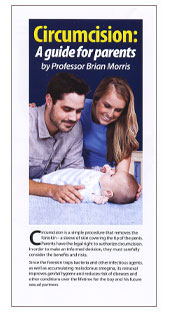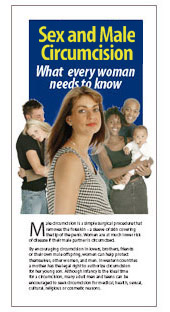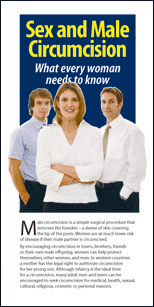Procedural Risks in Infants
Having described the benefits, let's look at the risks. Surgical complications for large published series range from 0.2% to 0.6% [Wiswell & Geschke, 1989; Cilento et al., 1999; Christakis et al., 2000, El Bcheraoui et al., 2014]. Higher rates of 2–10% have been reported in much older and smaller studies [Kaplan, 1983; Griffiths et al., 1985; Frank, 2000].
One large study, conducted in US Army hospitals from 1980 to 1985, found that for 100,157 boys who were circumcised in the first month of life, there were 193 complications (0.19%) [Wiswell & Geschke, 1989]. These included 62 local infections, 83 instances of hemorrhage (31 requiring ligatures and 3 requiring transfusion), 25 instances of surgical trauma, 20 urinary tract infections (compared with 88 UTIs in the 35,929 boys in this study who had not been circumcised), and 8 cases of bacteremia (compared with 32 in the uncircumcised). There were no deaths or reported losses of the glans or entire penis. However, in the uncircumcised boys, 3 developed meningitis, 2 developed renal failure and 2 died.
A large study, of 354,297 male infants born in Washington State from 1987–1996, noted a complication rate in the 130,475 who were circumcised during their newborn hospital stay of only 0.21% (1 in 476) [Christakis et al., 2000]. It was then calculated that 6 UTIs could be prevented for every circumcision complication, and 1 penile cancer could be prevented for every 2 complications.
Of 9,668 neonatal circumcisions performed in Kaiser Permanente Northern California hospitals none resulted in complications [Schoen et al., 2006].
In a small study of 500 New Zealand boys followed over a longer period, namely from birth to 8 years of age, the rate of penile problems was almost 2-fold higher in those who were not circumcised (19% versus 11%). Moreover, if both minor and more serious problems had not been lumped together, this study would have shown a much higher rate of problems in the uncircumcised [Fergusson et al., 1988].
In a small study of 500 New Zealand boys followed over a longer period, namely from birth to 8 years of age, the rate of penile problems was almost 2-fold higher in those who were not circumcised (19% versus 11%). Moreover, if both minor and more serious problems had not been lumped together, this study would have shown a much higher rate of problems in the uncircumcised [Fergusson et al., 1988].
An old study, spanning 1963 to 1972, in a US hospital in which circumcision rate was 94%, reported 111 of 5,521 newborns incurred a complication of any degree [Gee & Ansell, 1976]. Thus total complication rate was 2.0% (1 in 50). This included easily treatable outcomes as well as serious ones. For only 0.2% were adverse outcomes serious (a single case of a life-threatening hemorrhage, 4 systemic infections, 8 circumcisions of infants with hypospadias, and one complete denudation of the penile shaft). Thus risk was very low even in an old study like this one.
A study in 2005 of 19,478 circumcisions in Israel (on day 8 after birth), and made up of 83% ritual circumcisions and 17% involving a physician, found a complication rate of 0.34% [Ben Chaim et al., 2005]. The breakdown is shown below, to which has been added comments by Dr Sam Kunin, a urological surgeon from Los Angeles who is very experienced in the field of circumcision.
| – |
Excess skin left 0.19%. This can be illusory. Dr Kunin says that if a baby is chubby, has an abundant prepubic fat pad or scrotal swellings from hydrocele or hernia it may look like not enough skin has been removed, when in reality the circumcision has been a good one. One can test this by seeing whether the glans penis is apparent in the erect state. To do this one can depress the fat surrounding the penis at the 3.00 and 9.00 o’clock positions to the pubic symphysis. If the glans is seen the circumcision is satisfactory. If the inner layer of foreskin is not completely freed up before circumcision there may be uneven inner skin left. This can lead to ‘buried penis’, which is when the penis retracts into the fat pad. It can occur with the Mogen method and is avoided by Gomco. Adhesions can develop between the glans penis and the remnant of the foreskin. To avoid this, parents must be instructed to routinely push the skin off the glans. Buried penis after newborn circumcision is not permanent, however, and, in most cases, resolves as the infant becomes older and begins to walk [Erog˘lu et al., 2009]. Thus surgery for buried penis is not recommended in boys less than 3 years [Erog˘lu et al., 2009]. |
| – |
Acute bleeding 0.08%. Although rare, this is more prone to occur with a ritual shield. It cannot occur with the Plastibell. |
|
– |
Penile torsion 0.03%. This is congenital, but can be revealed by circumcision. It does not affect function |
| – |
Skin shortage 0.02%. This is unlikely to occur if the circumciser is experienced |
| – |
Wound infection 0.01%. Although rare, this can be more common with Plastibell, if instruments are not sterilized adequately, or if in a ritual Jewish ceremony the mohel performs metzitza b’ pe (the sucking of blood from the would by mouth – which can also lead to herpes simplex type 1 infection). |
| – |
Partial amputation 0.005% (n = 1). Partial amputation cannot occur with the Plastibell or Gomco clamp, but is a remote possibility for Mogen clamps or, in Jewish ritual circumcisions, shields. |
| – |
Inclusion cysts can occur, most often with the Mogen procedure, since freeing up the foreskin from the glans is blind and does not include cleaning out smegma, which becomes trapped in the line of the clamp to form a cyst. In Gomco and Plastibell a dorsal slit in the foreskin is made after clamping and at this time all inner connections can be released and smegma removed. |
Dr Kunin is acknowledged for the clinical explanations and advice above. He says that it is important to equate a given complication with what tool is used, but overall complications should approach zero for an experienced operator.
Thus, in this study, complications were rare, mild and virtually all easily correctable, with little difference in rate between ritual and medical circumcisions.
An overall summary of the various complications of circumcision in infancy and the rates of each appears below. This information is taken from references: [Wiswell & Geschke, 1989; Wiswell, 1992; Wiswell, 1995; Wiswell, 1997a; Alanis & Lucidi, 2004].
|
• |
Excessive bleeding: Occurs in 1 in 1,000. This is treated with pressure or locally-acting agents, but 1 in 4,000 may require a ligature, and 1 in 20,000 may need a blood transfusion because they have a previously unrecognized bleeding disorder. Hemophilia in the family is of course a contra-indication for circumcision. |
|
• |
Infection: Local infections occur in 1 in 100-1,000 and are easily treated with local antibiotics. Systemic infections may appear in 1 in 4,000 and require intravenous or intramuscular injection of antibiotics. |
|
• |
Subsequent surgery: Needed for 1 in 1,000 because of skin bridges, or removal of too much or too little foreskin. Repair of injury to penis or glans required for 1 in 15,000. Loss of entire penis: 1 in 1,000,0000, and is avoidable by ensuring the practitioner performing the procedure is competent. Injuries (rare) can be repaired [Baskin et al., 1997; Thompson et al., 2006; Shaeer et al., 2008] and in the extraordinarily remote instance of loss of the penis it can be reattached surgically [Ozkan & Gurpinar, 1997] and reconstruction is also possible [Beniamin et al., 2008; Shaeer, 2008]. (Successful reattachment can also follow adult self-inflicted penile amputation [Landström et al., 2004].) |
|
• |
Local anesthetic: The only risk is when the type of anesthetic used is a dorsal penile nerve block, with 1 in 4 having a small bruise at the injection site. This will disappear. |
|
• |
Death: Data in the records show that between 1954 and 1989, during which time 50,000,000 circumcisions were performed in the USA there were only 3 deaths, but during this period there were 11,000 from penile cancer, a disease essentially confined to the uncircumcised [Wiswell & Geschke, 1989; Wiswell, 1997a]. Wiswell found there were 2 deaths in those NOT circumcised, but NONE in the 3 times as many who were circumcised [Wiswell & Geschke, 1989]. The 3 deaths noted by Wiswell for the 35 years to 1989 were in children circumcised at home by a mohel (a Jewish religious circumciser). Both of them had hemophilia (a new genetic mutation in their families, as there was no family history in either case). The remaining death was due to infection in a 1.9 kg premature infant. In the largest published series of complications due to circumcision …. Speert's in the 1950s (~500,000 boys) [Speert, 1953], Wiswell’s in 1989 (~100,000 boys) [Wiswell & Geschke, 1989], and Christakis's in 2000 (~135,000 boys) [Christakis et al., 2000] …. there were no deaths from medical circumcisions. One death was reported by Speert, but involved a circumcision performed by a mohel who was not only unqualified, he wasn’t even registered with the New York board of mohelim. In a personal email communication in July 2009, Wiswell states “In the U.SA. I have not read of or heard of any NEONATAL circumcision deaths over the subsequent 20 years since our [1989] publication.” But for later circumcisions, Wiswell states “I am aware of one death in Cleveland just prior to a child's second circumcision at 4 months of age ... the parents did not like the appearance and a urologist agreed to do the second procedure. Prior to even starting, the anesthesiologist inadvertently injected air into the child's vascular system and the child died before even being cleansed for the procedure.” In the U.K., a report in 1949 by Gairdner noted 16 deaths "due to circumcision" during the World War II years, even though “circumcision” and “phimosis” were lumped together on autopsy sheets for cause of death. Jake Waskett points out (personal email communication in July 2009) that this death rate has been used by the anti-circumcision movement to incorrectly claim a “curiously precise figure of 220. The figure does not represent actual, documented deaths. The figure is an estimate, extrapolated from (a) the number of circumcisions performed annually in the USA, and (b) the death rate reported by Gairdner (16 in 90,000) in 1949 in the UK. Applying Gairdner's figures seems wholly inappropriate, given that he didn't study neonatal circumcision, but that of (mostly) older children, and as he noted most of the deaths were due to the complications of general anesthesia (using the now outmoded and more dangerous anesthetics chloroform or ether), which is not required in infancy. The American Academy of Family Physicians quote a figure of 1 in 500,000, citing King who in turn cited the study by Speert. This translates to about 1–2 deaths per year in the U.S.A. Such deaths are surely outnumbered by the number of deaths due to severe kidney infections that, in turn, are attributable to non-circumcision.” |
In Jewish ritual circumcision tightly wrapped gauze is used to stop minor bleeding (as compared to use of local pressure in hospitals), and it is thought that this can cause urinary retention and hence UTI [Harel et al., 2002]. Not surprisingly, complication rates are higher when circumcision is carried out by individuals who are not medically trained [Ozdemir, 1998].
Although very rare, complications from use of the Plastibell method have been reported, and include a higher rate of infection [Gee & Ansell, 1976], proximal migration and tissue strangulation if the Plastibell chosen is too large [Cilento et al., 1999], pressure necrosis of the glans if a Plastibell is used that is too small [Cilento et al., 1999], urinary retention [Mihssin et al., 1999], distended bladder [Ly & Sankaran, 2003], sepsis [Kirkpatrick & Eitzman, 1974; Lazarus et al., 2007] and post-operative bleeding because of failure to ensure that the ligature was tied sufficiently tightly [Lazarus et al., 2007]. In a study in Pakistan, the most common complication was Plastibell impaction, managed by cutting the Plastibell, and occurred in 2.3% of babies under 3 months, increasing gradually to 26.9% for children over 5 years [Samad et al., 2009]. To illustrate the rarity of complication, in a study of 2,000 neonates there were no serious sequelae at all [al-Samarrai et al., 1988]. In the case of the Gomco clamp excessive removal of foreskin tissue can occur [Gee & Ansell, 1976].
A 12-fold higher incidence of methicillin-resistant Staphyloccocus aureus (11 cases) has been seen in circumcised versus uncircumcised neonates during brief periods when there were outbreaks of this bacterium in a nonteaching community hospital [Nguyen et al., 2007]. Contributing factors were longer hospital stay, uncovered circumcision equipment, poor hand hygiene practices, and use of multiple dose lidocaine vials for the local anesthetic used. All of these are avoidable and can be addressed to greatly reduce this risk. None of the infants suffered long-term harm. Moreover, such occurrences are rare.
A meta-analysis on meatal stenosis after circumcision found an overall summary risk estimate of 0.66% [Morris & Krieger 2017a]. The meta-analysis included all published data from 27 studies (representing 350 cases of meatal stenosis amongst 1,498,536 males). In uncircumcised males meatal stenosis gradually increases in prevalence with age, mostly as a result of penile inflammation caused by lichen sclerosis, which is much more common in uncircumcised males [Morris & Krieger 2017a; Frisch & Simonsen 2018; Morris & Krieger 2018a,b]. Meatal stenosis in uncircumcised males is likely under-reported [Morris & Krieger 2017a]. Correct diagnosis can, moreover, present challenges [Morris et al., 2018b]. While more studies are warranted, the current data do not support meatal stenosis being a major adverse effect of MC.
Data from a large Danish study [Frisch & Simonsen 2018] were further evaluated by critics, revealing a prevalence of meatal stenosis of 0.099% in Muslim (circumcised) males and 0.12% in non-Muslim (uncircumcised) males, of all ages combined (0–60+ years), making the condition uncommon [Morris & Krieger 2018a]. In the Danish study, prevalence of other urethral stricture disease was 0.55% in Muslim and 0.82% in non-Muslim males [Frisch & Simonsen 2018; Morris & Krieger 2018a]. In elderly men prevalence of MS was 1.9-times higher in the uncircumcised [Frisch & Simonsen 2018]. Each condition was higher in younger ethnic Danish men circumcised for medical problems compared with uncircumcised Danish men [Frisch & Simonsen 2018]. Rather than being a long-term complication of MC [Van Howe 2018a], onset was found to occur in the first 2 months after neonatal MC [Salimi et al., 2017], but diagnosis is generally much later [Morris & Krieger 2018a]. Meatal stenosis prevalence may not differ over the lifetime of circumcised and uncircumcised males. Further research may in fact find a higher prevalence in uncircumcised males owing to gradual increase in prevalence with age as a result of the effect of inflammatory conditions that are much more prevalent in the uncircumcised.
Topical use of a lubricant (petroleum jelly) on the circumcision site after diaper change for 6 months prevented meatal stenosis in boys aged less than 2 years [Bazmamoun et al., 2008]. In the group not managed in this way, meatal stenosis was 6.6%. The lubricant also reduced infection (by 87%), bleeding (by 84%), and time to recovery (3.8 versus 4.2 days). This study did not include an uncircumcised group for comparison, so frequency of meatal stenosis in the absence of circumcision is not known in this Iranian population.
Analysis of a Danish national medical records databank led to a claim that “circumcision pain” causes autism spectrum disorder (ASD) and hyperkinetic disorder in boys aged 0–9 years circumcised before the age of 2 years [Frisch & Simonsen 2015]. Critics exposed numerous flaws in the study, pointing out that the number of cases was small, statistical significance was marginal, association was stronger in Muslim boys which might suggest a need for consideration of genetic or cultural influences, association with ASD of painful conditions more prevalent in uncircumcised boys (such as cystitis) was not examined, association with ASD diagnosis was found in boys under the age of 4 years, but not in boys aged 5–9 years, which is relevant to alternative explanations such as neuronal damage caused by analgesic usage on immature brains [Morris & Wiswell 2015]. General anesthesia, sometimes advocated for infant MC [Paix 2012], is neurotoxic and associated with later cognitive impairment [Ing et al., 2012]. It has generally been disavowed in favour of local anaesthesia [American Academy of Pediatrics 2012b; Dilley & Morris 2012]. Medications for post-EIMC analgesia – specifically, the use of acetaminophen (paracetamol), found in 1994 to be effective for management of post-circumcision pain [Howard et al., 1994], led the AAP to recommend it [American Academy of Pediatrics 1999]. In support of acetaminophen use, rather than infant circumcision, being responsible for the association, a US study by Bauer et al. found no association of EIMC with ASD prior to 1995 [Bauer & Kriebel 2013]. Unlike in older individuals, acetaminophen metabolism in immature brains generates neurotoxic by-products. Bauer criticized the Danish ASD study for falsely suggesting that her group’s findings applied to EIMC [Bauer 2015]. These observations may also explain why the older boys in the Danish study (i.e., boys born before the introduction of the guidelines in 1999) showed only a weak association of MC with autism, whereas the younger ones (born after 1999) showed a stronger association. Another Danish study [Sneppen & Thorup 2016] found an extraordinarily high prevalence of ASD of 7.2% in uncircumcised boys. They suggested that the figure of 1.5% reported by Frisch and Simonsen for uncircumcised Danish boys [Frisch & Simonsen 2015] indicated confounding in the latter study. Diagnosis of ASD has been rising steady over the years but has now plateaued in males at 3.6% in the US [Zablotsky et al., 2017; Xu et al., 2018] and 3.7% in South Korea [Kim et al., 2011], whilst rate of circumcision has been steadily declining in each country. Other authors have also criticized the Danish autism study [Neyer 2015; Sjøgren 2015].
Not surprisingly, nonmedical, co-called “community circumcision” of infants and children is associated with higher risk of complications, as reported in the U.K. [Corbett & Humphrey, 2003].
It should be stressed that there are contraindications to infant circumcision in the case of prematurity, family history of bleeding disorders (hemophilia), penile abnormalities (hypospadias, epispadias, micropenis, ambiguous genitalia, megalourethra, webbed penis) in which the foreskin might be required to reconstruct the penis at a later date [Alanis & Lucidi, 2004]. However, the use of tubularized incised plate urethroplasty has virtually eliminated the need for skin flaps in anterior hypospadias repair [Pieretti et al., 2008].
Thus risks in doing a circumcision are exceedingly low.
• Risk-benefit analysis.
http://www.circinfo.net/pdfs/risk-benefits_v3.6.pdf



